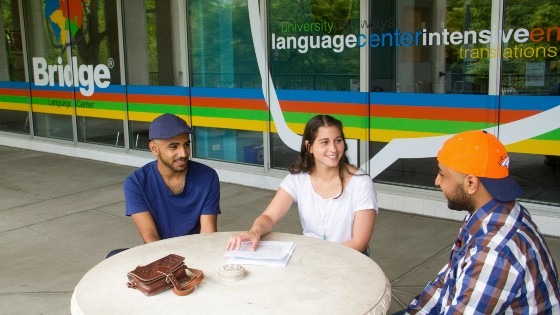This guest post is the first in a series by Bridge partner, Jake Young, who spent ten years teaching in the Czech Republic before dedicating himself to his ESL resource website for teachers, Fluentize. Based on his own experience learning to speak Czech, Jake shares the many ways learning any new language can make you a better English teacher.
If you’re new to teaching, you’ll want to get initial training and qualification with a TEFL certificate. You can explore our online TEFL courses to get started!
One valuable life experience which has helped me incredibly throughout my professional development as an ESL teacher is learning a second language. In my case, the second language I went through the (painful) process of learning was Czech. After giving it a lot of thought, I really feel that learning a second language helped me improve my English teaching skills in a number of ways.

Jake, ESL teacher and creator of Fluentize
Learning a Second Language Develops Your Empathy
From a teacher’s perspective, I believe that it’s valuable to understand the emotional struggles that come with learning a language. And one great way to do this is to actually put yourself in the shoes of a language learner.
When you’re in a language class from the perspective of a learner, you get to know the feeling of making mistakes, the challenge of expressing your ideas clearly, making sense of the grammar rules, pronouncing words the right way, getting embarrassed, and feeling nervous to speak. This experience can then help you improve your communication skills as a teacher with your own students and give you an idea how to respond to the difficulties they have. And most importantly, you’ll have a better sense of how to help them overcome these struggles and challenges.
While I don’t think that you necessarily have to learn a second language in order to have empathy as a language teacher, I do feel that being on the other side of the desk provides you with a humbling experience that can be of value for teaching.
Learning a Language Provides Good Ideas for Your ESL Lesson Activities
When you take foreign language lessons, whether Spanish, Arabic, or, in my case, Czech, you get the opportunity to see first-hand what kinds of activities work – and don’t work. Think about it as killing two birds with one stone – you’re learning a new language but also learning new teaching techniques and activities.
Try to be aware of and even take notes on what activities your teacher did with you that you thought were helpful, useful, interesting, engaging, or effective, as well the ones that were ineffective, boring, or too hard. Ask yourself – what helped you improve? What was effective for you? Then you can take these activities, put your own twist on them and/or improve them for your own lessons.
I’ve collected many ideas from my teachers during my Czech language education that I then flipped around to use with my own students. This helped me save lesson planning time and also gave me solid material that I knew worked well.
I remember one great speaking activity my teacher made for me.
I remember it being fun and useful for me and so I turned around and did the same with some of my private students in our conversation lessons. It turned out to be a great speaking activity and my students loved to practice their speaking in this way. So don’t forget to take notes on what your language teacher does with you and what works well!
For more ideas you can use in the TEFL classroom, download this free BridgeTEFL eBook: Teaching English to Adults.
The next two points only apply to teachers who are learning or have learned the native language of their students, but I believe can still give you good insight.
Learning Your Students’ Language Gives You a Personal & Linguistic Connection
TED-Ed has a great video about the benefits of a bilingual brain:
This video explains how bilingual people can usually be divided into three different categories:
1. Compound
The learner is typically very young when they start learning/using a second language. They use their native language and second language both at home and at school. They process the world around them in both languages. There is no separation.
2. Coordinate
The learner uses their native language in one environment (at home, for example) and then uses the second language in another environment (at school, for example) so both languages are separated according to which environment they’re in.
3. Subordinate
The learner typically learns a second language by filtering it through their first language (translating, memorizing grammar rules, and then using these concepts in a real-world context.)
If you have adult students, there are high chances that some of them fall in the subordinate category, filtering English through their first language. This basically means that as they speak English, they are filtering or translating their thoughts from their native language, and as they listen to someone speak English, they are translating it to their native language. This is how communication and understanding generally work for a subordinate bilingual.
Understand the structure of your students’ language to understand their mistakes
So if you have students in the subordinate category, then learning and reaching a high level of their native language can help you communicate more accurately and clearly with them. If you understand the grammatical and phonetic structure of their language, then when they speak and make mistakes, you know why they’re making those mistakes and what they’re trying to convey.
Have the ability to use translation when needed
You’ll also be able to facilitate the filtration process for them through translation. Although translation may be looked down upon in the classroom, check out a great blog post by an ESL teacher in Prague, Kamila Linkova, who quoted an expert named Peter Newmark. He’s an English professor of translation at the University of Surrey, who suggested that translation can be beneficial to language learning in terms of accuracy, clarity, and flexibility. As an example, chances are your lower-level students will have a tougher time understanding the following phrases if they are defined or explained in a foreign language, as opposed to translated to their native language:
It can take you much more time to explain how to use these idiomatic expressions than it is to simply translate them to your students’ native language. Often it’s much more effective to just translate them, and additionally go through definitions and examples of these expressions in use in English. It’s also important to point out that you don’t have to (and actually you shouldn’t) constantly use your students’ native language throughout the whole lesson. But you might see how effective and helpful it can be to be able to communicate with them in their native language from time to time.
Furthermore, if you know their native language, you’ll gain a better understanding how they think, why they used the wrong word in the wrong context, and how the grammatical structure of their language works. There have been many times when my students weren’t able to think of a word in English, they said it in Czech, and then I was able to translate it immediately for them. This helps them process the language so that they’ll be able to use it more actively.
Learning a Language Provides Insight Into the Cultural Topics that Matter to Your Students
It’s often said that language is the heart of a culture. When you take foreign language lessons, you’ll probably learn a lot about the culture and people of the country/countries where that language is spoken. When you do this, you’ll gain a deeper understanding of what traditions, sports, hobbies, films, public figures, holidays and a range of other things that your students know a lot about, want to talk about, and really hit their heart.
Engage students with content relevant to them
When students have an emotional connection to the learning content, they tend to be more motivated to speak their mind about it. And the more speaking there is in the lesson, the more it will lead to opportunities for you to correct their speech and help them express themselves. When you learn a second language, a lot of these special cultural topics will come to surface and be integrated as part of the lesson. In return, this gives you great material to turn around and use for teaching topics in your own lessons.
There have been a few topics that we’ve studied in my Czech language courses that taught me something special about the culture. I remember talking specifically about mushroom picking. I really had no idea that mushroom picking was even a thing that existed! After having some interesting discussions on mushroom picking as a student in my language lessons, I decided to turn it around and make some lesson plans for my students on the same topic. I found a good video to use on the topic of mushroom hunting and made this mushroom picking lesson plan.

My Czech students loved working on the topic because they could relate personally to it! All the students seemed to be engaged and have something to say about it. It also introduced a lot of new and useful vocabulary terms relevant to mushroom picking, thereby bringing practicality to their language-learning experience.
By Learning Another Language, You’ll Learn More About the Building Blocks of English
While this one may sound a bit counter-intuitive, you will actually learn a lot about English from studying a foreign language. The reason for this is that you’re going to compare and relate everything you learn about a new language back to your native tongue, which will help you understand the building blocks of English.
For example, when studying Czech language, I found that the structure of their verbs relied heavily on prefixes. A prefix actually functions very similarly to a preposition in English language, specifically in the context of phrasal verbs. One quick example would be the verb “rozpadat” in Czech language. The “-padat” part of the verb is the base, and expresses the same meaning as the verb “to fall” in English. The prefix “roz-” generally expresses the sense of coming apart, breaking, or separating. So you can actually deduce the meaning of the verb “rozpadat” if you understand both its base and prefix without having to memorize it as a whole. You can do the same with many of English’s phrasal verbs. Think about the phrasal verb “fall apart.”
So, with some of my Czech students, I went through some of their basic verbs and the different prefixes they attach to them, and we compared those prefixes to English prepositions and phrasal verbs. We found a lot of commonalities between them. This helped put some difficult phrasal verbs in perspective with a clearer context that matched their basic linguistic understanding of the verb. It helped them to distinguish the similarities between English language’s phrasal verbs and the way that they use prefixes on the verbs in their native tongue.
Another example that comes to mind was helping my students understand the present perfect and why we use it in English. After coming to my own understanding how Czechs express “an action which started in the past and continues until now,” it was much easier for me to clarify the usage of this concept, present perfect, to Czechs, who struggle a lot with this tense. I was able to show students the English structure of the tense relative to how it would be expressed in Czech language.
The bottom line here is that I’ve found that digging into or dissecting the nuances of another language will help you understand the nuances of English, and therefore strengthen your teaching abilities and why things are formed the way they are in the language.










